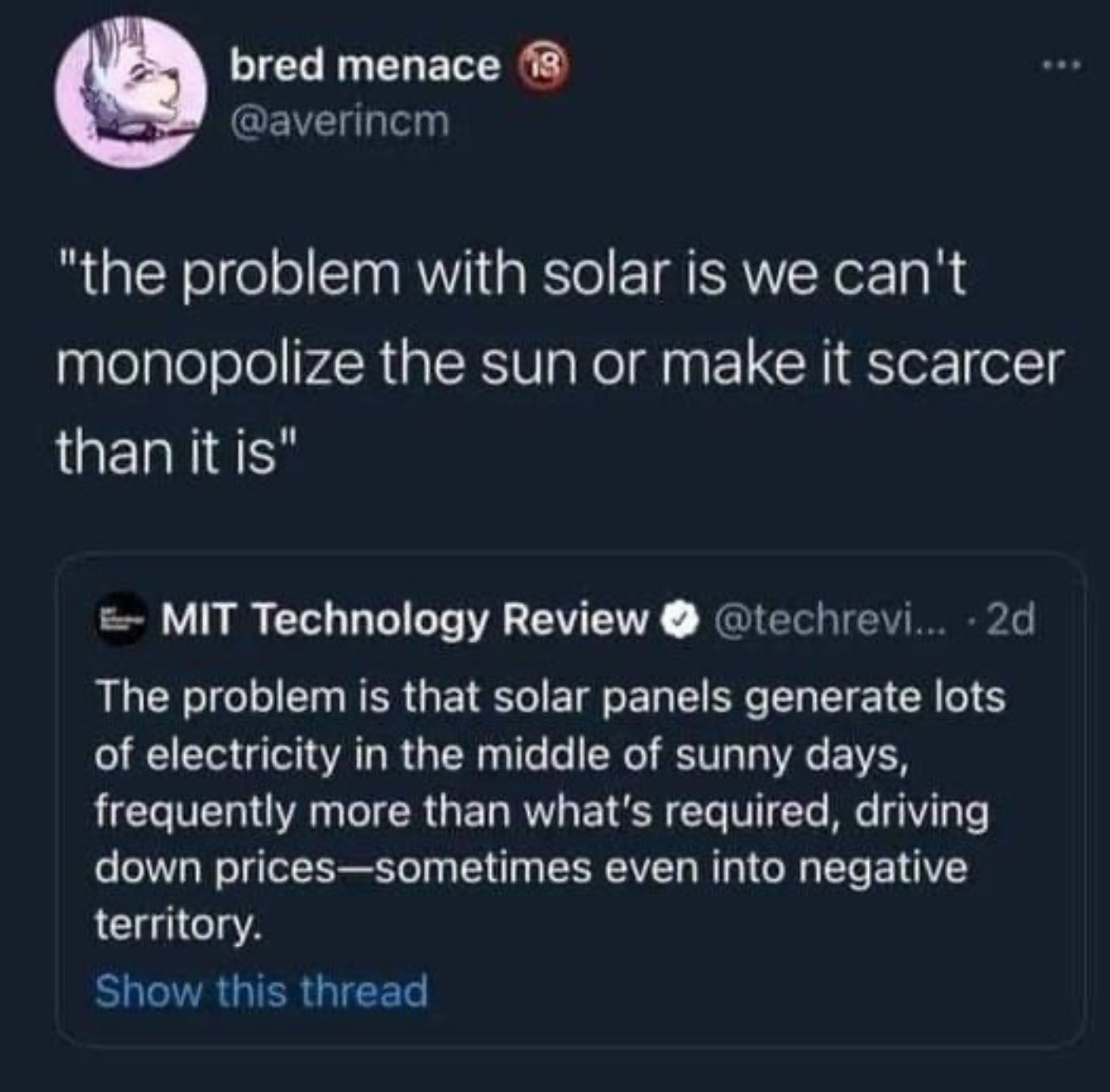this post was submitted on 02 Oct 2024
1702 points (95.6% liked)
Microblog Memes
6647 readers
2575 users here now
A place to share screenshots of Microblog posts, whether from Mastodon, tumblr, ~~Twitter~~ X, KBin, Threads or elsewhere.
Created as an evolution of White People Twitter and other tweet-capture subreddits.
Rules:
- Please put at least one word relevant to the post in the post title.
- Be nice.
- No advertising, brand promotion or guerilla marketing.
- Posters are encouraged to link to the toot or tweet etc in the description of posts.
Related communities:
founded 2 years ago
MODERATORS
you are viewing a single comment's thread
view the rest of the comments
view the rest of the comments

It is a financial problem. Technically you can just cover the solar panels. But that's not good financially.
Your "technically you can" is actually a huge logistical nightmare to implement.
Having electricity rates go really low is intended to incentivize people or companies to sink the excess energy to wherever they can. And also to discourage producers to produce more at that hour, if they are able to.
Logistical problems are still financial problems though. That's my point. Hire enough people/develop the appropriate automation and the issue is no more.
We have the technology to solve this, the problem is the money.
In fact, you could just buy enough batteries and the problem will also go away. Still a financial problem, not a technology one.
EDIT: just to clarify, if at some point energy prices go negative, it means that it is cheaper to buy energy usage than a solution. Unless the energy company is dumb enough to just lose money for the lazyness of considering other options.
You could spend the money, but you also need to consider whether that money is well spent. Batteries do not last forever. Maybe that money is better spent on R&D to develop better batteries first. Also natural resources and environmental impact needs to be considered. Batteries take natural resources to build and also occupies a lot of space.
20 years ago, we also have the technology to run AI workloads. Except we probably had to deploy billions of CPUs to match the capability of today's GPUs. We have the technology then, but it is not practical. And that money was much better spent in the R&D that lead to today's GPUs. So similarly our batteries probably needs to be a few magnitude better than what we have today before it is practical to use.
Really? I'm seriously asking, because I thought solar farms already had automated ways of cleaning off the panels, surely an automated way to cover the panels wouldn't be any more complex than that. It would add maintenance costs for sure, but calling it a logistical nightmare seems like an exaggeration.
Most use a horizontal single axis configuration and could just tilt the panels away from the sun.
The real question that we should be asking, is why nobody can think of what to do with free energy?
Desalination? Mine Bitcoin? Giant space laser?
It's not a question of ideas, it's a question of money. Building things to use excess power costs a lot of money.
In some markets, the power price actually goes negative and consumers can be paid to use energy.
https://edition.cnn.com/2024/09/20/energy/three-mile-island-microsoft-ai/index.html
I think there's plenty of money out there to use excess power, someone just has to connect the dots...
Or in a pinch: just run big-ass space heaters. Seriously. It's a stupid way to burn off excess power, but it's dirt simple and cheap. Just have a big array of resistive heaters out in an empty field somewhere with a high fence around it. Need to burn off an extra GW? Run it through massive heating elements and burn burn it off. It's a stupid waste of good energy, but as an emergency backup, it's not a bad option. It's trivially easy to dispose of huge amounts of excess electricity if you just run the mother-of-all space heaters. Run your stupid giant resistive heater at the bottom of a lake for even better effect.
You need to consider more than just solar farms. There are many roof top solar systems on people's houses. That's what I'm referring to regarding logistical nightmare.
Second, if we are just going to cover up solar panels, then it really defeats the purpose of having it. A better way is to come up with ways to store this excess energy to use when there is low production and not have to depend on fossil fuels at night.
Yeah I understand storing and using the energy is obviously a better solution than to stop producing the energy. But in the short term, in the context of large solar arrays, until we have storage solutions or ways to use* the excess, covering the panels up or turning them to face the ground for a bit doesn't seem like a very big logisticical hurdle.
Are there really enough residential rooftop panels for this to even be a problem? And couldn't it be solved just by installing a battery for your home to store the excess? Again, if you could explain how this would be a logistical nightmare for my ignorant self, I'd appreciate it.
Afaik photovoltaics are fine running open circuit, i.e., disconnecting them. Thermal solar, and wind, are (I think) much trickier (but covering things for solar thermal, like you suggest, is perhaps feasible).